в… . Introduction
PeopleвҖҷs higher expectation for their physical appearance leads to the early orthodontic treatment. Increasing number of young patients who begin orthodontic treatment in their childhood and juvenile period has been reported [1,2]. And the percentage of orthodontic treatment in pediatric dentistry is also increasing. Parents of young patients with skeletal class II malocclusion tend to easily perceive such as lip protrusion and convex profile in their children and feel the need for orthodontic treatment.
Skeletal class II malocclusion occurs as a result of skeletal disharmony, arising from overgrowth of maxilla or undergrowth of mandible or the combination of both. Class II malocclusion can be divided into division I and division II, according to the level of inclination of maxillary incisors. Class II division I occurs when maxillary incisors are proclined, while Class II division II is categorized as the maxillary incisors are retroclined [3].
Many of the orthodontic patients in both pediatric and orthodontic department fall into the category of Class II division I. According to Yang et al. [4], class II division I malocclusion accounts for 34.6% of the orthodontic treatment cases among the patients who visited chonnam national university pediatric dental hospital. Jung MH5) reported that patients, who visited orthodontic dental clinic found that Class II division I patients accounted for 34.8% of all the malocclusion patients.
It is very important to diagnose the accurate cause of class II malocclusion whether malocclusion was caused by the overgrowth of maxilla, or the undergrowth of mandible, since the method and timing of treatment can be changed depending on the cause [6]. Precise analysis of patientвҖҷs profile and lateral cephalograms is very important for accurate orthodontic diagnosis. Early treatment for class II malocclusion is recommended to relieve sociopsychological problem, although the effectiveness of the early treatment is still controversial [7].
In the department of pediatric dentistry of chonnam national university, except for the undergrowth of the mandible cases, skeletal class II division I patients in the juvenile period are usually treated with cervical headgear and Hotz appliance, and successful improvements were observed(Fig. 1). Three cases which were given different succeeding treatment respectively will be introduced in the following part.
в…Ў. Case Reports
1. Case 1
A 10-year-old female patient visited the hospital with the complaint of upper incisor protrusion and lower anterior crowding. Profile and cephalometric analysis was conducted for diagnosis. Her cephalometric radiographs showed that she had U1 to SN of 113.5Вә, which meant upper incisor labioversion and the arch length discrepancy of mandible was +5 mm. It was also found that she had large ANB (4.5Вә) and overjet (5 mm). She was diagnosed with class II division I malocclusion caused by maxillary overgrowth. It was decided to use a cervical headgear and Hotz appliance for primary treatment. She was instructed to wear a headgear 14 hours a day and to wear Hotz appliance all day except during the meals. The force applied on the appliance at the beginning of the treatment was 300 gm for each side, which is relatively weak pressure, and was increased to 400-450 gm afterward. She put on the headgear an average of 12 hours a day and showed high level of cooperation. As a result of 7-months treatment, U1 to SN decreased from 113.5Вә to 104Вә, overjet from 5 mm to 1 mm, and ANB from 4.5Вә to 2.5Вә. Meanwhile, vertical growth pattern was intensified as FMA increased from 35Вә to 37.5Вә, SN to MP from 43Вә to 45.5Вә(Fig. 2). Both upper incisor protrusion and skeletal class II malocclusion were improved through the primary orthopedic treatment, but the lower anterior crowding still remained. To solve this problem, fixed orthodontic treatment started.
2. Case 2
A 10-year-old male patient visited the hospital with the complaint of upper incisor labioversion and eruption disturbance of lower left second premolar. Cephalometric analysis showed that he had U1 to SN of 124Вә, which indicated labioversion. He also had overjet of 10 mm and overbite of 4 mm, which were quite large. He also had eruption problem because of lack of space for lower left second premolar. He was diagnosed with Class II division I malocclusion with severe protrusion of maxillary incisors. We started treatment using a cervical appliance and Hotz appliance. Distal screw appliance was applied to mandible to gain a space for lower second premolar. During the treatment, he frequently changed appointments. Also, appliance was often fractured and not fitted well, so it had to be re-produced. Even the facebow was fractured twice. He was not very compliable to our instruction to wear a headgear 14 hours a day, leading to prolonged treatment. Writing a headgear calender proved to have low effects on him. As a result of 12- months treatment, U1 to SN was decreased from 124Вә to 113Вә, overjet from 10 mm to 5 mm, and ANB from 4.5Вә to 4Вә. Lower second premolar erupted as the space was successfully gained(Fig. 3, 4). The patient was cooperative when the treatment procedure began. However, as the treatment proceeded, he became not much cooperative. He did not apply the appliance as instructed, and began to break the treatment appointments. And during the last three months, he never showed up. Upper incisor labioversion and skeletal class II malocclusion was somewhat improved, but still in need of continuing treatment. Therefore, we decided to stop using a cervical headgear and Hotz appliance, and began to use class II activator for retention and additory orthopedic treatment, which is much more wearable.
3. Case 3
A 12-year-old female patient had upper anterior crowding and bruxism. Cephalometric analysis showed that she had ANB of 8Вә, which meant she had severe skeletal class II malocclusion. Both upper and lower lip was protruded, as UL to EL was +5.5 mm, while LL to EL was +9 mm. She also had a convex profile. However, she is different from the previous cases, as she has U1 to SN of 107.5Вә, which falls into a normal range. Considering her young age, a cervical headgear and Hotz appliance was used. Hotz appliance was expected to solve the problem of upper anterior crowding, since it is able to expand maxilla. She was instructed to wear a Hotz appliance for more than 20 hours a day and a headgear for 14 hours a day. 400-450 gm of force was applied to each side of the headgear. The treatment was wrapped up in 6 months due to high level of cooperation from the patient. After treatment, U1 to SN was decreased from 107.5Вә to 92.5, overjet from 6 mm to 2 mm, and ANB from 8Вә to 6.5Вә. Upper anterior crowding and a large overjet was improved, but the problem of disharmony between maxilla and mandible, and upper and lower lip protrusion were still remained(Fig. 5, 6). Further treatment was recommended, but the patient and her parents were satisfied with the present condition and did not want to receive succeeding treatment. Therefore, we finished the primary treatment by applying Hotz appliance as a retainer. It seems that, for this case, extraction orthodontic treatment was not avoidable, if appropriate treatment was not given in the growing phase of the patient.
в…ў. Discussion
Headgear is an extraoral device which is used for Class II malocclusion cases with protrusion of maxilla for the purpose of preventing overgrowth of maxilla. Headgear is more appropriate for Class II malocclusion with maxillary overgrowth, compared to other intraoral devices such as twin block appliance and activator, because it is able to move maxilla backward using extraoral force. Headgear can be divided into three types, high pull headgear, straight pull headgear and cervical headgear, according to the direction of force. Since high pull headgear prevents upper molar extrusion, and cervical headgear extrudes it, it is important to select an appropriate appliance, considering the projection of vertical growth and the level of overbite [8,9]. However, as the effects on retraction of maxilla by high pull headgear are weaker than those of cervical headgear, it is recommended to use a cervical headgear first, and then use high pull headgear, in case disharmony between mandible and maxilla is big [10]. A cervical headgear should not be used in cases with openbite, since it can extrude maxillary molar [9].
Hotz appliance is usually used in combination with a cervical headgear for the treatment of class II division I malocclusion. Hotz appliance is similar with Schwarz appliance in that it comes with a expansion screw, but it is distinguished from Schwarz expander because it is produced after a band is applied to maxillary first molar. It is difficult to retain the appliance using adams clasp since the band is attached, so buccal extension arm is used for retention(Fig. 1). When Hotz appliance is used in combination with a headgear, the skeletal effects of a headgear are enhanced and the proclined upper incisors are retracted by labial bow activation. In addition, maxillary expansion can be achieved if necessary. If maxillary arch is not expanded when maxillary teeth is retracted, posterior cross-bite may occur [11].
When a headgear is used alone, overall skeletal effects are not remarkable, and the force is focused only on first molars. Currently, at pediatric department of chonnam national university dental hospital, a headgear is used for the Class II division I patients in combination with a Hotz appliance. It is considered that this treatment scheme has optimum effects when given during late mixed dentition and early permanent dentition. It is recommended to begin the treatment before maxillary second molar begins to erupt [12]. As in the case 3, this treatment can be used as camouflage treatment, even in the case U1 to SN is in the normal range. When crowding is accompanied on the mandible, Schwartz appliance or lingual arch are recommended to use along with a headgear and Hotz appliance.
When using removable orthopedic appliances like Hotz appliance and headgear, it is very important to gain cooperation from patients, because their cooperation is decreased as the period of treatment is increased. To solve this problem, a number of studies are performed to find ways to strengthen patientsвҖҷcooperation for treatment using headgear [13-15]. According to Clemmer et al. [14], females are more cooperative than males, and the possibility of better cooperation is increased when patients are deeply conscious of their status of malocclusion. Carleton et al. [15] reported that patients tend to believe they wear the appliances for longer hours than actually they wear. So, it was recommended to use a headgear calender. Our hospital also recommends patients who show low level of cooperation to write the hours on the calender to enhance patientвҖҷs cooperation and to check the hours of application. In this way, patients feel more obligated for timely treatment and they can get instant feedback, leading to better cooperation. Therefore, a headgear calender may be used as an useful tool for orthopedic treatments using removable appliance including headgear. The second patient in this study showed decreasing cooperation with wearing a headgear, and did not visit the clinic for regular check-up during the last three months of the treatment phase. Writing a headgear calender did not work on this patient. However, he became cooperative after appliance is changed from a headgear to Class II activator. Changing type of appliance may be one way to recoup patientsвҖҷcooperation when their cooperation level falls.
The effect of early treatment of skeletal class II malocclusion has been debated and studied steadily. In many studies, it was revealed that the ideal age for class II malocclusion is the late mixed dentition or the right before adolescent growth spurt. Also, it was found out that the two-phase treatment scheme did not make significant influence on the result of the treatment, and did not show noticeable advantages when compared with the one-phase treatment [16-20]. But it is important to consider psychological needs from patients and their parents before beginning the treatment. Parents may feel serious and anxious on the dental condition of their child when they have a protruded anterior teeth or serious skeletal disharmony, because they may be bullied for these reasons. OвҖҷBrien et al. [7] stated that children in their early mixed dentition showed improved self-concept and social acceptance after the treatment. Since it is required for a good pediatric dentist to consider psychological advantages as well as physical aspects, it is recommended to introduce early orthodontic treatment if there is the possibility of sociopsychological problems caused by skeletal class II malocclusion.
Class II division I malocclusion treatment using Hotz appliance and cervical headgear is categorized as the first phase orthodontic treatment. Types of succeeding treatment depends on the result of the first phase treatment. Patients may satisfy with the result of the first phase treatment, but in most cases, they need to receive succeeding treatment using fixed appliance. Or, high pull headgear or functional appliance such as class II activator need to be applied. The cases introduced in this study were aimed at improving disharmony between maxilla and mandible, class II molar relation, and protruded maxillary incisor. The problem of skeletal disharmony, crowding, deep overbite, and lack of cooperation may remain after the first phase treatment, and appropriate succeeding treatments need to be followed, according to patientвҖҷs needs and dental status. A close attention is required during treatment process since molar relation can be shifted to Class III if excessive force is applied or the treatment is not terminated within an optimal period. Also, proper screw turn is required for the expansion of the maxilla, depending on individual needs. It requires continuous effort on the part of practitioners to earn high level of cooperation from patients.
в…Ј . Summary
This case report is about three class II division I malocclusion patients with overgrown maxilla and protruded maxillary incisor. They began orthodontic treatment utilizing cervical headgear and Hotz appliance in growth phase. The results of the first phase treatment are as follows. 1. Their SNA and ANB were decreased. 2. Upper incisors were retracted. 3. Lip protrusion was reduced. 4. FMA was increased. After the first phase treatment using cervical headgear and Hotz appliance, succeeding treatment was followed according to the needs of patients as follows. 1. fixed orthodontic appliance for mandibular anterior crowding 2. Class II activator for the improvement of class II malocclusion. 3. Retention using Hotz appliance.



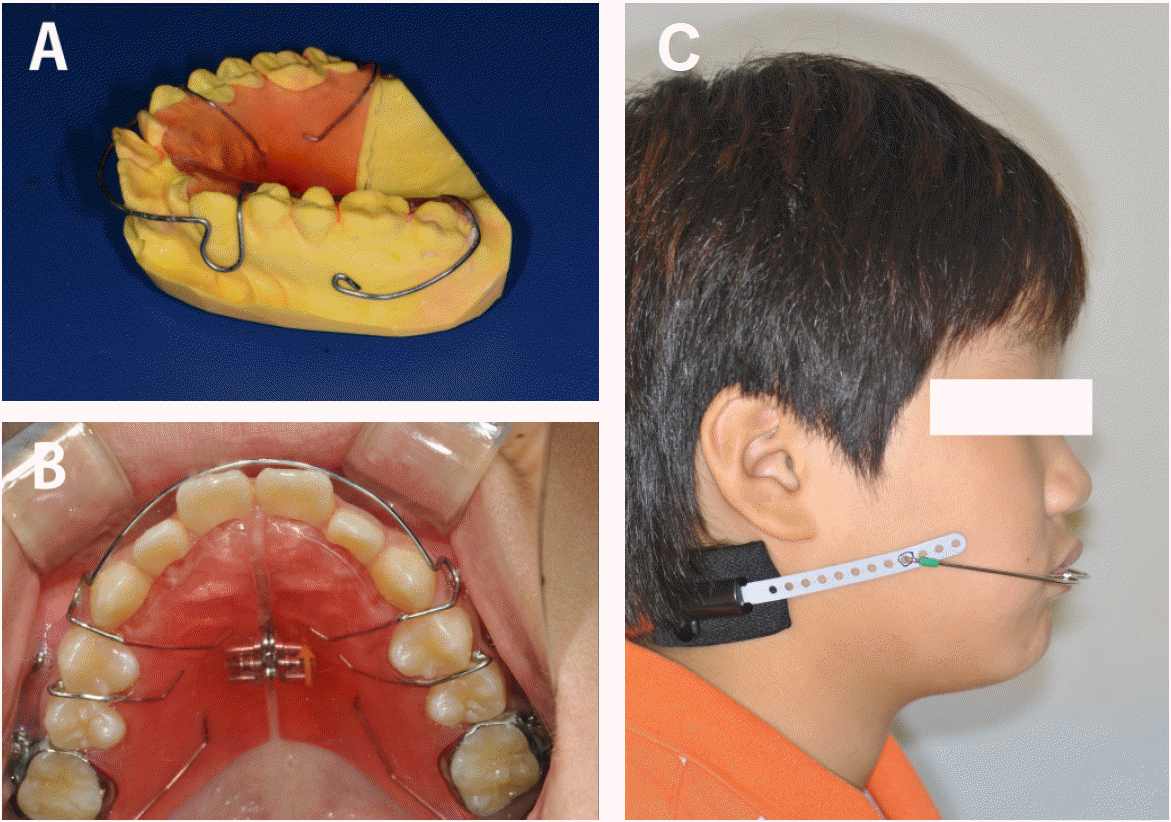
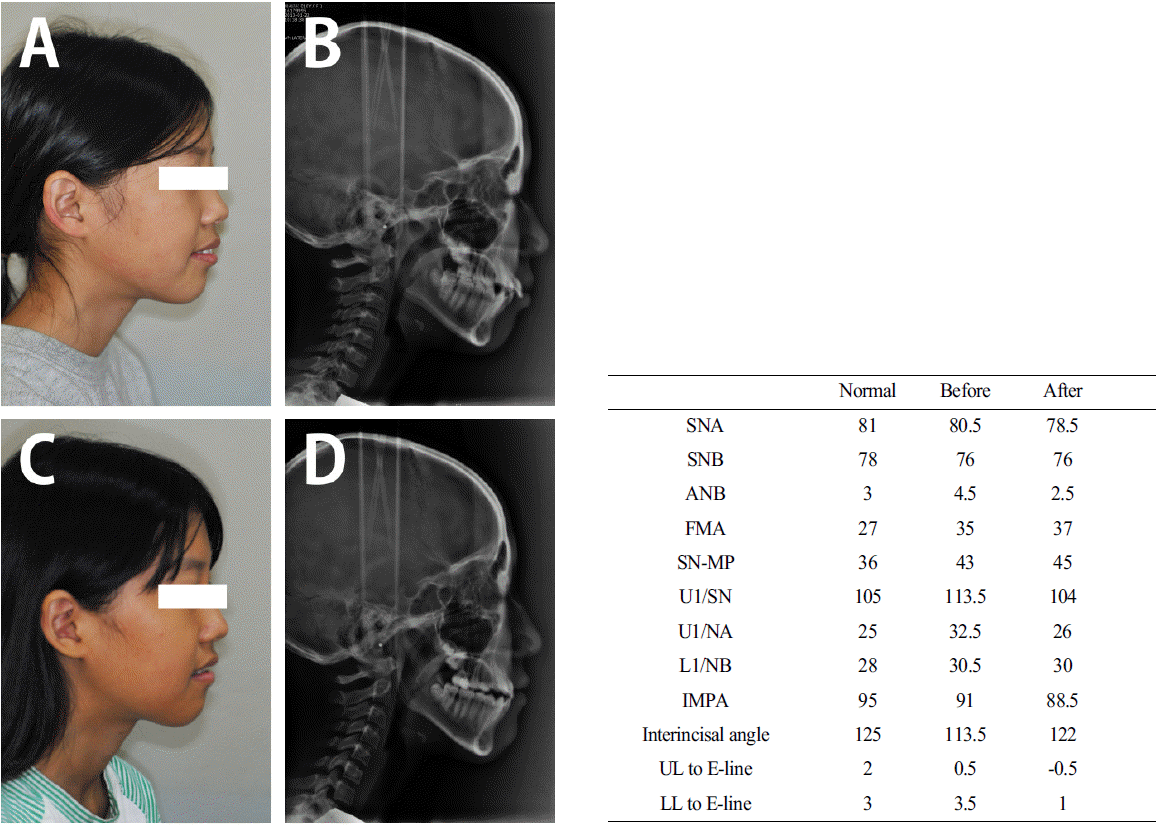

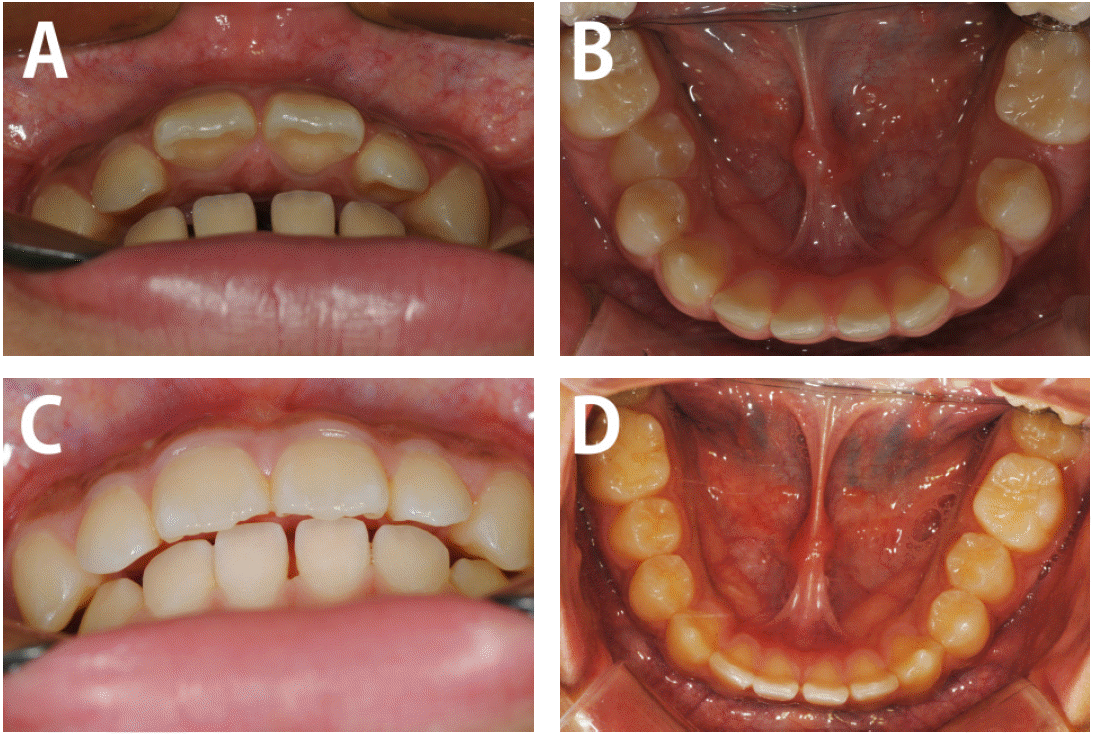
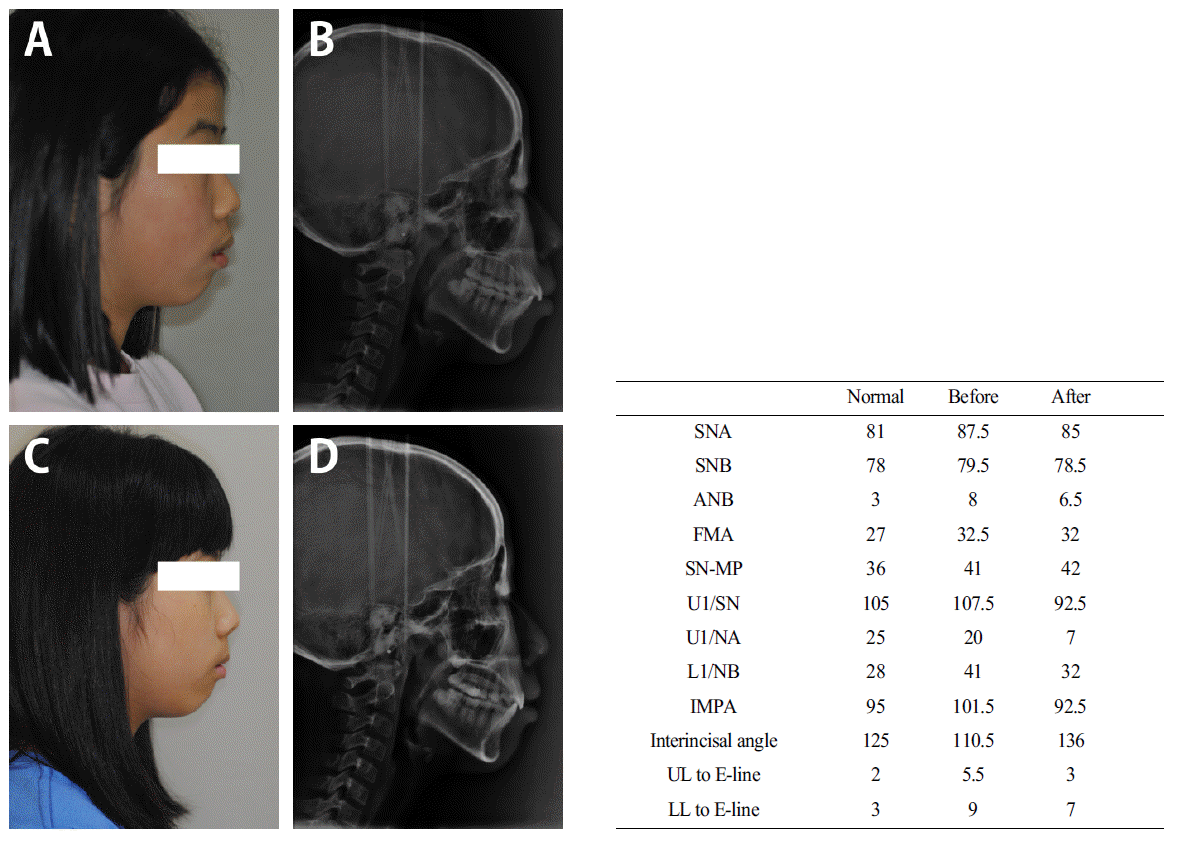
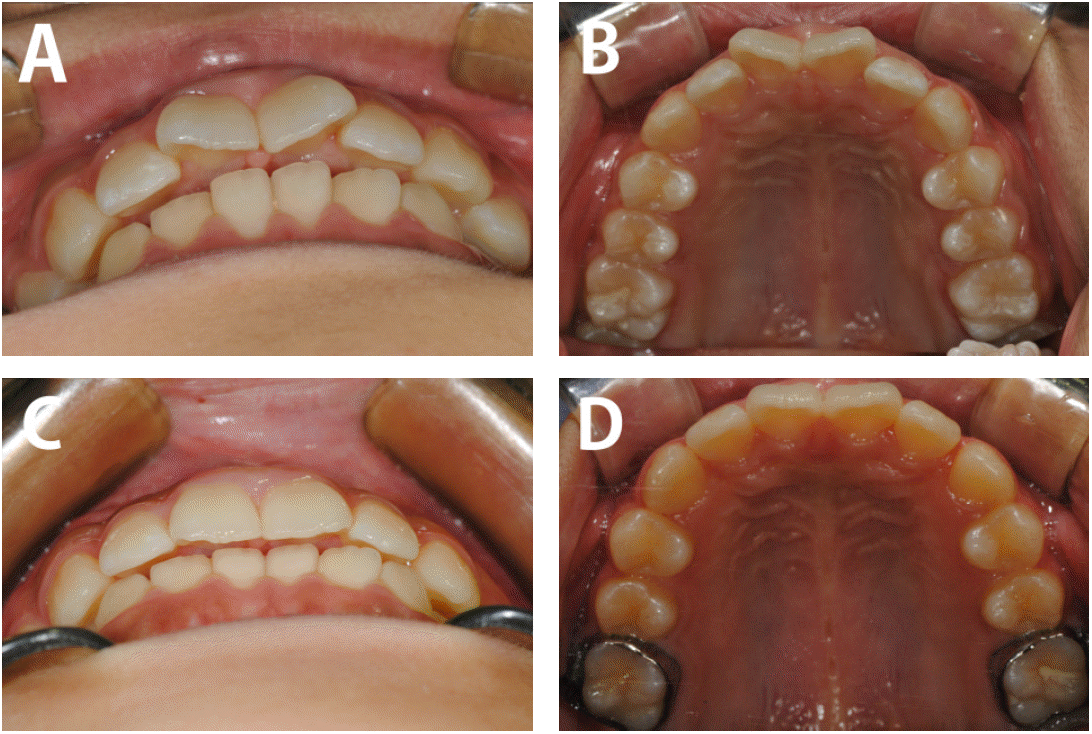
 PDF Links
PDF Links PubReader
PubReader ePub Link
ePub Link Full text via DOI
Full text via DOI Download Citation
Download Citation Print
Print






